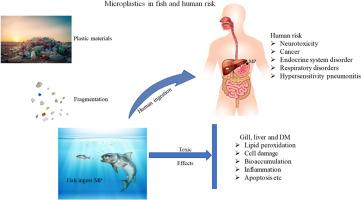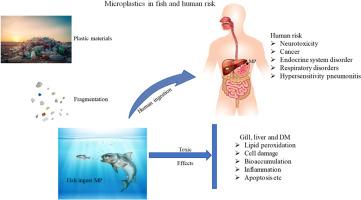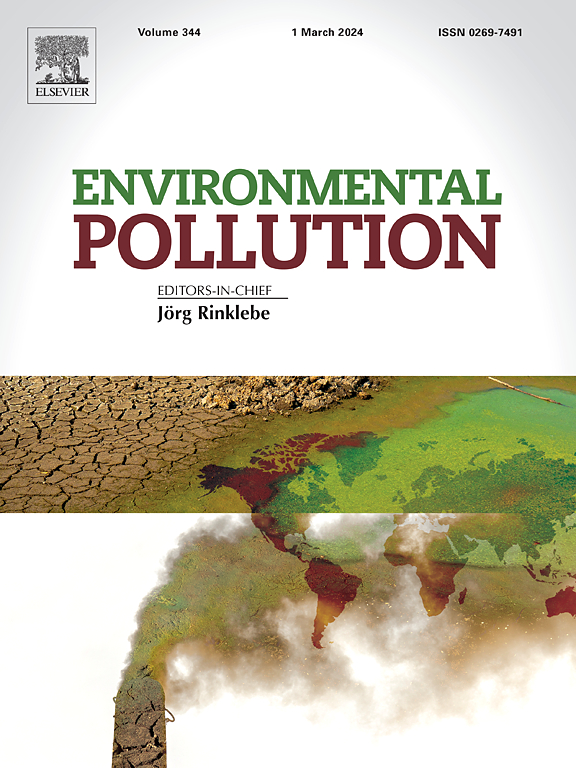尼日利亚扎里亚 Kubanni 水库库氏鲤和黑线鲈的微塑料污染及相关人体健康风险分析
IF 7.6
2区 环境科学与生态学
Q1 ENVIRONMENTAL SCIENCES
引用次数: 0
摘要
近年来,由于全球微塑料污染的增加,环境安全已成为人们关注的主要问题。这些无处不在、微小且可能有毒的塑料颗粒通过大型塑料的风化和微珠的释放进入水生环境。尽管许多研究都关注发达地区的微塑料污染,但来自发展中国家的信息仍然有限。这项研究评估了尼日利亚扎里亚库巴尼水库的两种商品鱼类(鲶鱼和尼罗罗非鱼)体内 MPs 的存在以及相关的氧化应激反应,时间跨度为旱季和雨季,历时六个月。经鉴定,纤维是最丰富的 MP 颗粒,其次是碎片、薄膜和珠子,顺序为纤维> 碎片> 薄膜> 珠子。鳃中的纤维浓度最高,鲫鱼的纤维浓度为11.5MP/个,而黑线鲈的纤维浓度为22.5MP/个。摄入的微塑料以黑色为主,最常见的微塑料在 1.0 至 2.0 毫米之间。主要聚合物为聚丙烯和聚对苯二甲酸乙二醇酯。在两种鱼的鳃部、肝脏和背肌中都观察到了氧化应激和细胞损伤的证据,这与摄入 MPs 有关。根据欧洲食品安全局关于儿童和成人食用鱼类的建议,食用库巴尼水库中的石首鱼和黑线鲈的人可能会接触到 70 至 700 种 MP/器官。摄入鱼鳃和内脏中发现的 MPs 所带来的风险明显更高,这对人类健康构成了重大威胁。这项研究深入揭示了库巴尼水库中具有重要商业价值的鱼类体内的微塑料污染情况,并强调了食用该生态系统中受污染鱼类所带来的环境和公共健康风险。本文章由计算机程序翻译,如有差异,请以英文原文为准。


Analysis of microplastic contamination and associated human health risks in Clarias gariepinus and Oreochromis niloticus from Kubanni Reservoir, Zaria Nigeria
Environmental safety has become a major concern in recent years due to the global increase in microplastic pollution. These ubiquitous, tiny, and potentially toxic plastic particles enter aquatic environments through weathering of larger plastics and the release of microbeads. Although numerous studies have focused on microplastic pollution in developed regions, information from developing countries remains limited. This study assessed the presence of MPs and associated oxidative stress responses in two commercial fish species, Clarias gariepinus (Catfish) and Oreochromis niloticus (Nile Tilapia), from Kubanni reservoir, Zaria, Nigeria, over six months spanning both the dry and rainy seasons. Fibers were identified as the most abundant MP particles, followed by fragments, films, and beads, in the order of fibers > fragments > films > beads. The highest fiber concentrations were recorded in the gills, with Clarias garipinus showing 11.5 MP items/individual and Oreochromis niloticus showing 22.5 MP items/individual. Black microplastics were predominant, and the most common ingested MP ranged from 1.0 to 2.0 mm. The primary polymers identified were polypropylene and polyethylene terephthalate. Evidence of oxidative stress and cellular damage was observed in the gills, liver, and dorsal muscles of both fish species, which correlated with MPs ingestion. According to recommendations from the European Food Safety Authority regarding fish consumption by children and adults, individuals consuming Clarias gariepinus and Oreochromis niloticus from the Kubanni reservoir may be exposed to between 70 and 700 MP items/organ. The risk associated with consuming MPs found in fish gills and guts was notably higher, posing significant concerns for human health. This study provides insights into microplastic contamination in commercially important fish from the Kubanni Reservoir and highlights the environmental and public health risks associated with consuming contaminated fish from this ecosystem.
求助全文
通过发布文献求助,成功后即可免费获取论文全文。
去求助
来源期刊

Environmental Pollution
环境科学-环境科学
CiteScore
16.00
自引率
6.70%
发文量
2082
审稿时长
2.9 months
期刊介绍:
Environmental Pollution is an international peer-reviewed journal that publishes high-quality research papers and review articles covering all aspects of environmental pollution and its impacts on ecosystems and human health.
Subject areas include, but are not limited to:
• Sources and occurrences of pollutants that are clearly defined and measured in environmental compartments, food and food-related items, and human bodies;
• Interlinks between contaminant exposure and biological, ecological, and human health effects, including those of climate change;
• Contaminants of emerging concerns (including but not limited to antibiotic resistant microorganisms or genes, microplastics/nanoplastics, electronic wastes, light, and noise) and/or their biological, ecological, or human health effects;
• Laboratory and field studies on the remediation/mitigation of environmental pollution via new techniques and with clear links to biological, ecological, or human health effects;
• Modeling of pollution processes, patterns, or trends that is of clear environmental and/or human health interest;
• New techniques that measure and examine environmental occurrences, transport, behavior, and effects of pollutants within the environment or the laboratory, provided that they can be clearly used to address problems within regional or global environmental compartments.
 求助内容:
求助内容: 应助结果提醒方式:
应助结果提醒方式:


